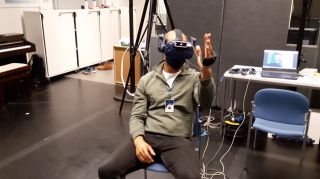Stroke
Music Therapy and Virtual Reality Boost Post-Stroke Function
Studies show music therapy and virtual reality reverse "neurologic neglect."
Posted February 13, 2024 Reviewed by Michelle Quirk
Key points
- "Neglect" is a neurological disorder impacting stroke survivors’ motor skills and critical perceptual domains.
- Several studies show improved task performance and brain activity through music therapy and VR interventions.
- Music therapy combined with virtual reality may be a more engaging neglect rehabilitation approach.
By Andrew Danso, Ph.D.
Did you know that after a stroke, nearly one-third of survivors face a challenging condition known as "neglect"? This neurological disorder significantly impacts a stroke survivor's rehabilitation, affecting their motor skills and critical perceptual domains, such as spatial awareness.
Visuospatial neglect (VSN) is particularly notable, where patients struggle to identify objects in areas of their visual field, often on their left side (though not exclusively). This often leads to increased risks of falls and heightened caregiver stress.
Traditional rehabilitation can be tough on both patients and therapists, leading to issues with patient and diagnostic challenges for therapists. The lack of a standardised treatment for VSN and neglect exacerbates this issue, leading to recent research efforts focused on developing treatment solutions.
Two recent studies (study 1 and study 2) have pointed out the promise of using music therapy and virtual reality (VR) as potential treatment experiences for VSN patients.
In music therapy, a practice known as Musical Neglect Training (MNT) involves patients actively participating in musical exercises. In these exercises, patients are instructed to play musical patterns (that can be melodic or rhythmic) on different musical instruments, which extend to the neglected visual field (commonly their left side, but not exclusively). A music therapy study showed promising findings in this area.
VR has also shown promise in this area. Recent studies have demonstrated its effectiveness in the diagnosis and assessment of VSN, as well as in motivation. The studies highlight core advantages of VR treatment for VSN, including
- Customisable treatment experiences
- Immersive patient experiences

Additionally, a research team found evidence of an increase in brain activity regions of neglect patients after using a VR intervention, linked to improvements in their saccadic eye movements—a rapid eye glance from one point to another.
A recent study attempted to combine a MNT and VR intervention. The initial findings of this combined approach were promising. Across various patient measures, patients showed varied results in engagement and response. A few patients reported improvements in task performance, suggesting a VR and MNT combined exercise could positively impact rehabilitation. Another study currently in peer review found promising results in VSN patients’ engagement and positive feedback while using a custom-made VR application for treatment. In addition, they found one patient’s task response time might have improved considerably with the use of audio cues.
These studies provide glimpses into the future of tailored rehabilitation and are promising in the ongoing development of rehabilitation treatments for stroke and neglect.
Andrew Danso, Ph.D., is a postdoctoral researcher at the Music Therapy, Centre of Excellence in Music, Mind, Body and Brain, University of Jyväskylä, Finland.
References
Danso, A., Leandertz, M., Ala-Ruona, E., & Rousi, R. (2022). Neglect, Virtual Reality and Music Therapy: A Narrative Review. Music and Medicine, 14(3).
Danso, A., Nijhuis, P., Ansani, A., Hartmann, M., Minkkinen, G., Luck, G., Bamford, J.S., Faber, S., Agres, K.R., Glasser, S., Särkämö, T., Rousi, R., & Thompson, M. R. (2023). Virtual Reality-Assisted Physiotherapy for Visuospatial Neglect Rehabilitation: A Proof-of-Concept Study. arXiv preprint arXiv:2312.12399.
Ekman, U., Fordell, H., Eriksson, J., Lenfeldt, N., Wåhlin, A., Eklund, A., & Malm, J. (2018). Increase of frontal neuronal activity in chronic neglect after training in virtual reality. Acta Neurologica Scandinavica, 138(4), 284–292.
Heyse, J., Carlier, S., Verhelst, E., Vander Linden, C., De Backere, F., & De Turck, F. (2022). From Patient to Musician: A Multi-Sensory Virtual Reality Rehabilitation Tool for Spatial Neglect. Applied Sciences, 12(3), 1242–1242.
Kang, K., & Thaut, M. H. (2019). Musical neglect training for chronic persistent unilateral visual neglect post-stroke. Frontiers in Neurology, 10, 474.
Moon, H.-S., Shin, S.-W., Chung, S.-T., & Kim, E. (2019). K-CBS-based unilateral spatial neglect rehabilitation training contents utilizing virtual reality. 1–3.
Schwab, P. J., Miller, A., Raphail, A.-M., Levine, A., Haslam, C., Coslett, H. B., & Hamilton, R. H. (2021). Virtual Reality Tools for Assessing Unilateral Spatial Neglect: A Novel Opportunity for Data Collection. Journal of Visualized Experiments, 169.
Wagner, S., Preim, B., Saalfeld, P., & Belger, J. (2019). Crossing iVRoad: A VR application for detecting unilateral visuospatial neglect in poststroke patients. 1–2.


